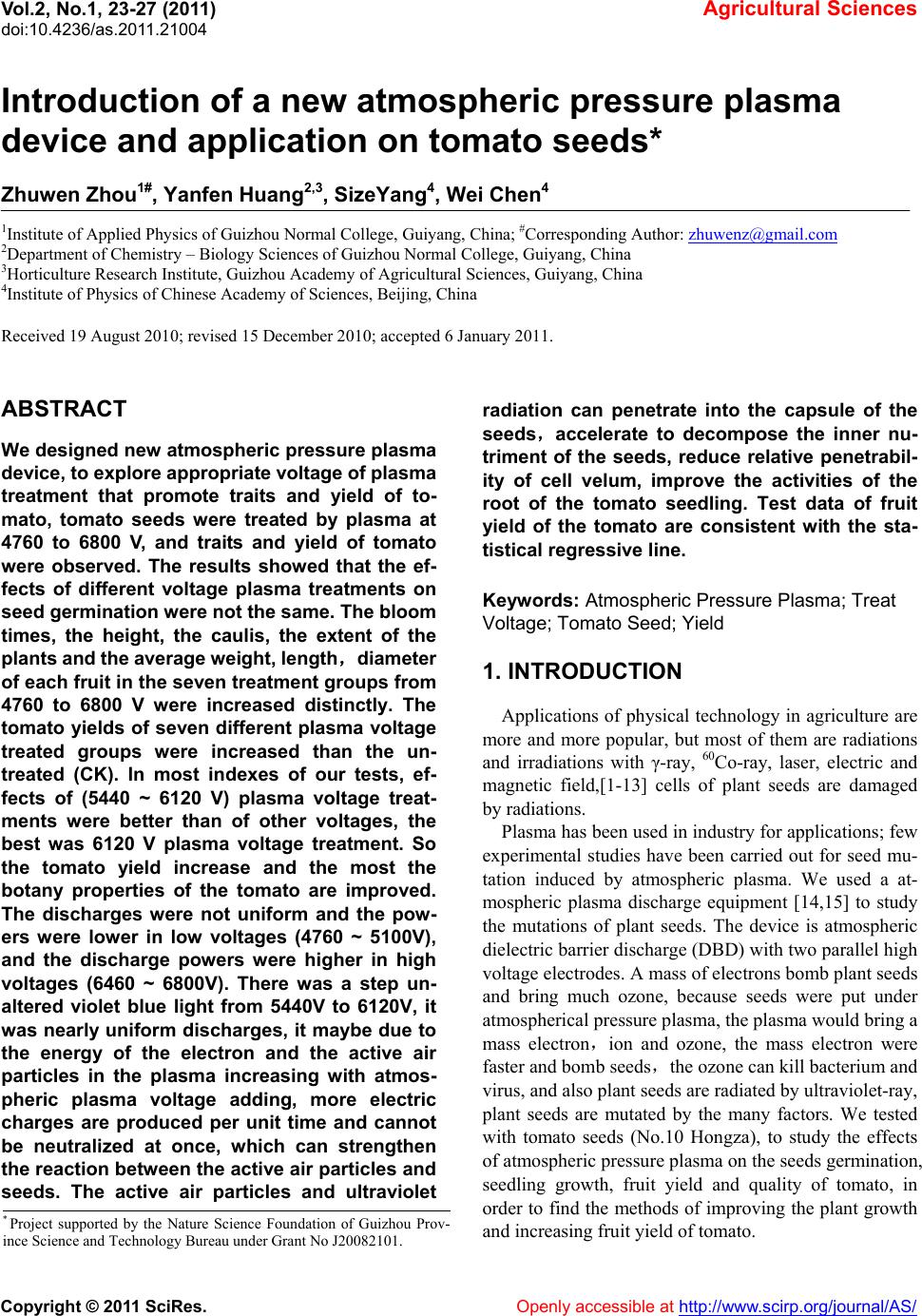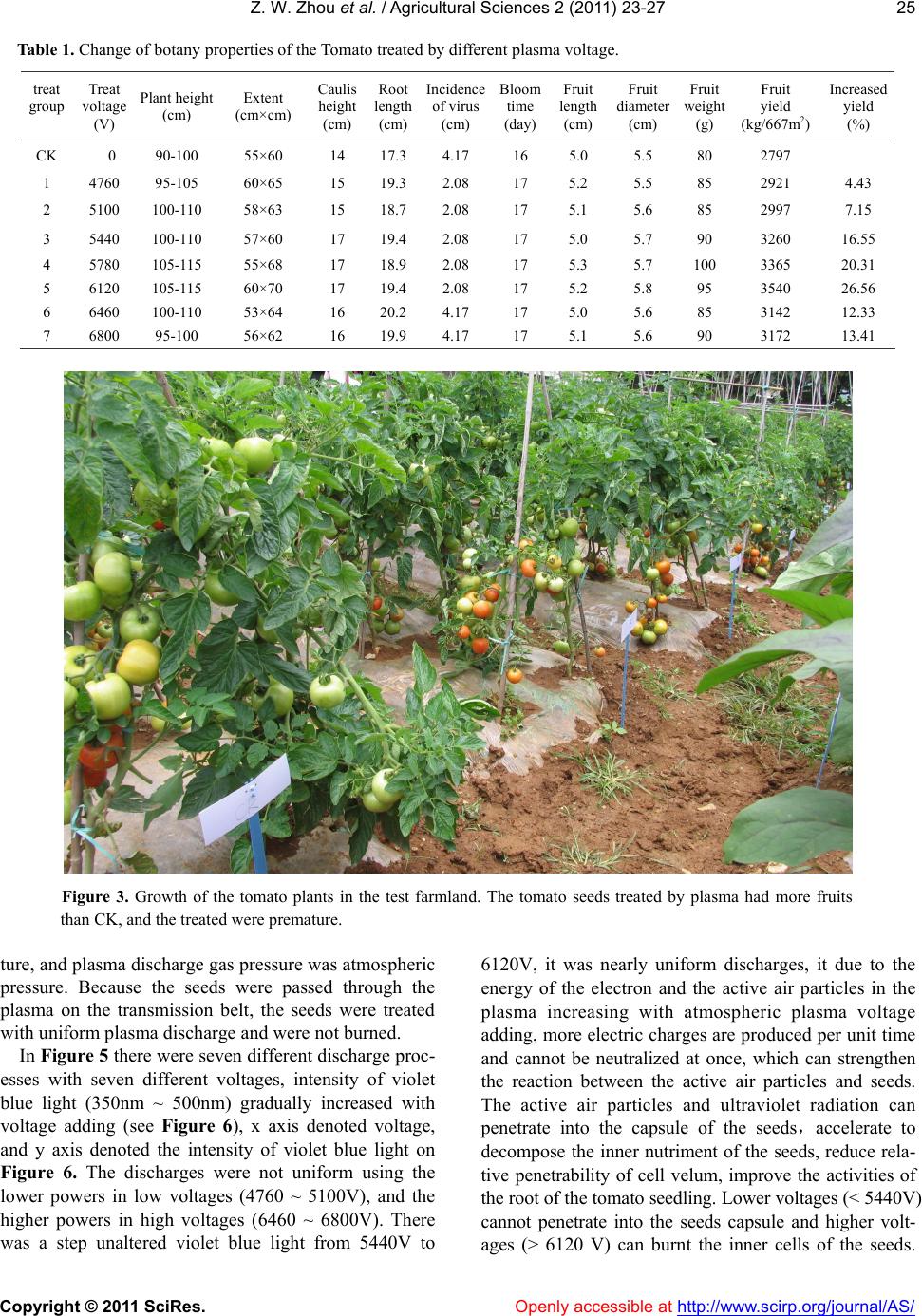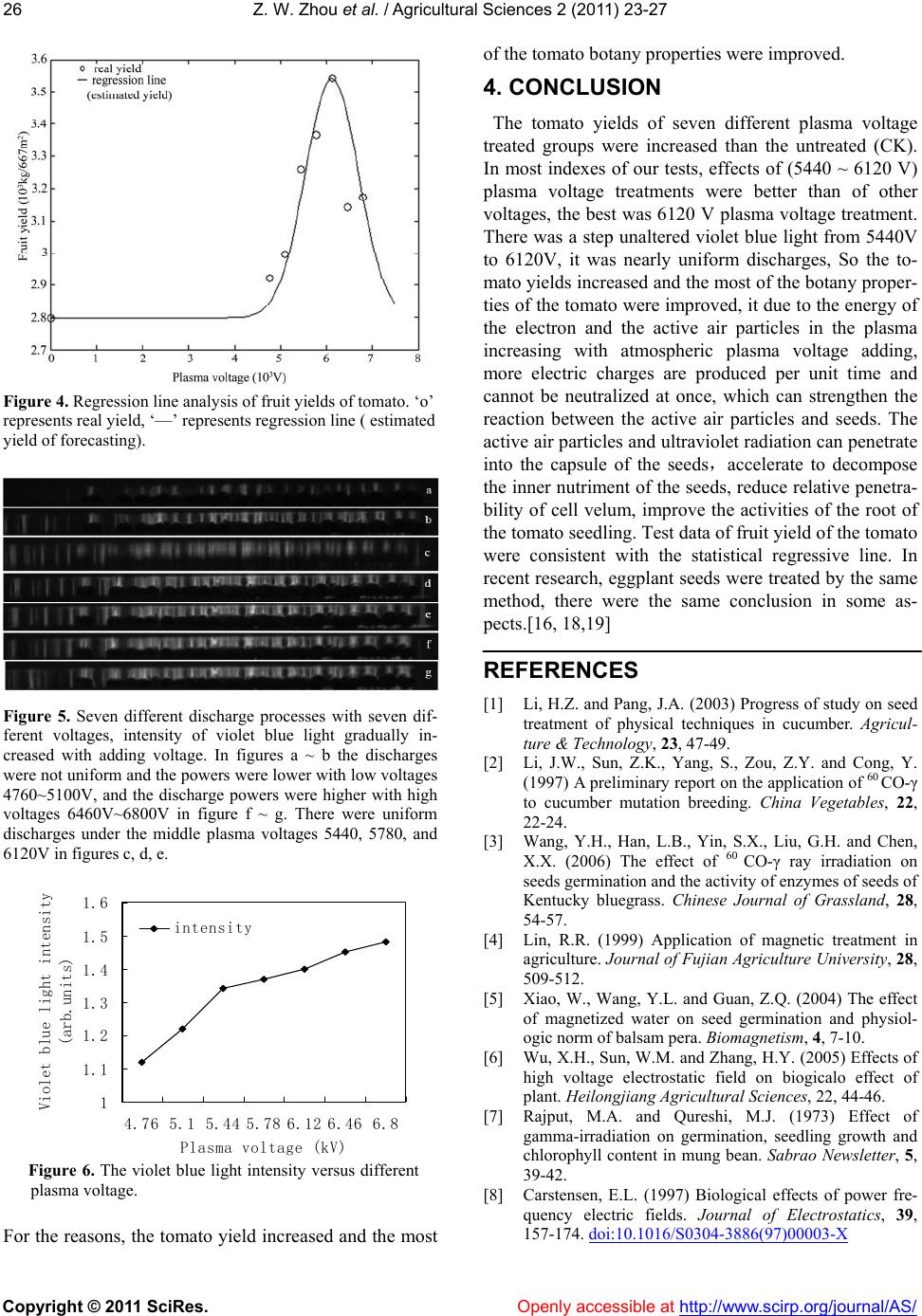Paper Menu >>
Journal Menu >>
 Vol.2, No.1, 23-27 (2011) Agricultural Sciences doi:10.4236/as.2011.2 1004 Copyright © 2011 SciRes. Openly accessible at http://www.scirp.org/journal/AS/ Introduction of a new atmospheric pressure p lasma device and application on tomato seeds* Zhuwen Zhou1#, Yanfen Huang2,3, SizeYang4, Wei Chen4 1Institute of Applied Physics of Guizhou Normal College, Guiyang, China; #Corresponding Author: zhuwenz@gmail.com 2Department of Chemistry – Biology Sciences of Guizhou Normal College, Guiyang, China 3Horticulture Research Institute, Guizhou Academy of Agricultural Sciences, Guiyang, China 4Institute of Physics of Chinese Academy of Sciences, Beijing, China Received 19 August 2010; revised 15 December 2010; accepted 6 January 2011. ABSTRACT We designed new atmospheric pressure plasma device, to explore appro priate v oltage of pl asma treatment that promote traits and yield of to- mato, tomato seeds were treated by plasma at 4760 to 6800 V, and traits and yield of tomato were observed. The results showed that the ef- fects of different voltage plasma treatments on seed germination were not the same. The bloom times, the height, the caulis, the extent of the plants and the average weight, length,diameter of each fruit in the seven treatment groups from 4760 to 6800 V were increased distinctly. The tomato yields of seven different plasma voltage treated groups were increased than the un- treated (CK). In most indexes of our tests, ef- fects of (5440 ~ 6120 V) plasma voltage treat- ments were better than of other voltages, the best was 6120 V plasma voltage treatment. So the tomato yield increase and the most the botany properties of the tomato are improved. The discharges were not uniform and the pow- ers were lower in low voltages (4760 ~ 5100V), and the discharge powers were higher in high voltages (6460 ~ 6800V). There was a step un- altered violet blue light from 5440V to 6120V, it was nearly uniform discharges, it maybe due to the energy of the electron and the active air particles in the plasma increasing with atmos- pheric plasma voltage adding, more electric charges are produced per unit time and cannot be neutralized at once, which can strengthen the reaction betw een the active air particles and seeds. The active air particles and ultraviolet radiation can penetrate into the capsule of the seeds,accelerate to decompose the inner nu- triment of the seeds, reduce relative penetrabil- ity of cell velum, improve the activities of the root of the tomato seedling. Test data of fruit yield of the tomato are consistent with the sta- tistical regressive line. Keyw ords: Atmospheric Pressure Plasma; Treat Voltage; Tomato Seed; Yield 1. INTRODUCTION Applications of physical technology in agriculture are more and more popular, but most of them are radiations and irradiations with γ-ray, 60Co-ray, laser, electric and magnetic field,[1-13] cells of plant seeds are damaged by radiations. Plasma has been used in industry for applications; few experimental studies have been carried out for seed mu- tation induced by atmospheric plasma. We used a at- mospheric plasma discharge equipment [14,15] to study the mutations of plant seeds. The device is atmospheric dielectric barrier discharge (DBD) with two parallel high voltage electrodes. A mass of electrons bomb plant seeds and bring much ozone, because seeds were put under atmospherical pressure plasma, the plasma would bring a mass electron,ion and ozone, the mass electron were faster and bomb seeds,the ozone can kill bacterium and virus, and also plant seeds are radiated by ultraviolet-ray, plant seeds are mutated by the many factors. We tested with tomato seeds (No.10 Hongza), to study the effects of atmospheric pressure plasma on the seeds germination, seedling growth, fruit yield and quality of tomato, in order to find the methods of improving the plant growth and increasing fruit yield of tomato. * Project supported by the Nature Science Foundation of Guizhou Prov- ince Science and Technology Bureau under Grant No J20082101.  Z. W. Zhou et al. / Agricultural Sciences 2 (2011) 23-27 Copyright © 2011 SciRes. Openly accessible at http://www.scirp.org/journal/AS/ 24 2. EXPERIMENT The test device is shown in Figure 1, it is two parallel containers made of quartz, the thickness of quartz is 1mm, the length is 15 cm, the width is 5cm, the space of dielectrics is 10mm. there are some liquid of potassium chloride in two containers, two inner copper rings dipped in the liquid are two electrodes connected to AC high voltage power supply 30 kV with frequency 8 ~ 30 kHz. Different plant seeds were treated with different plasma voltages, for example, tomato seed for 4760 ~ 6800V, eggplant seed for 4420 ~ 6800V [16], cucumber seed for 5610 ~ 7310V [15]. As compact joined between the liquid of potassium chloride and dielectrics, both cool quartz dielectrics and uniform plasma were discharged. In our experiment, the tomato seeds were uniformly put on a transmission belt at constant speed, turned on high voltage power supply to discharge, the seeds passed through the plasma, treat- ment time were controlled by the speed of the belt. There were seven different voltage (4760, 5100, 5440, 5780, 6120, 6460 and 6800 V) treatments with the same treatment time 6 seconds, the different voltages were produced between two parallel high voltage electrodes and the plasma charges occurred in atmospheric pressure environment, therefore the experiment is called atmos- pheric dielectric barrier discharge (DBD). The process of treating the seeds by plasma device is shown in Figure 2. 3. RESULTS AND DISCUSSION We designed an atmospheric pressure plasma device. The tomato seeds were treated by different voltage from 4760 to 6800 V. The results showed that the effects of different voltages plasma treatments on seed germination and growth were not the same. The height (90 ~ 100cm), the caulis (> 14cm), the extent(> 55×60cm)of the plant and the single fruit weight(> 80g), the length(≥ 5.2cm), the diameter(≥ 5.5cm)of the tomato of seven treatments from 4760 to 6800 V were increased distinctly in Table Figure 1. Schematic diagram of the atmospheric plasma di- electric barrier discharge (DBD). Figure 2. Process of treating seeds by plasma device. 1. In addition, anti-virus of seven treatments (incidence 2.08%) were better than the untreated except sixth and seventh treatment (incidence were as same as the un- treated 4.17%). The bloom times of all the treated seeds were longer and earlier than the untreated (CK), as well as the maturity time (Figure 3). The tomato yields of seven different voltage plasma treatments were increased, the fifth, the fourth and the third treatments were better than the untreated (CK), the yields of the three treat- ments increased 26.56%, 20.31%, 16.55% than CK. In Figure 4 there were obviously increasing yields of the tomato under the proper plasma treatment voltages ranges (5440 ~ 6800V), the figure showed that some experimental data compared with Gaussian distribution curve of the fruit yields of the tomato by using a regres- sion line estimate statistical method, the Gaussian dis- tribution curve was regression equation: 2 yaexpb xcd , here a = 0.743, b = 1.500, c = 6.120, d = 2.797. The Gaussian distribution curve was comparatively con- vinced since the F-value was calculated: F =5675 > F 0.05(1, 5)=6.61, remain standard error: s = 0.02, it showed that the error was very small between real fruit yields and estimated. In 5440 ~ 6120 V voltage ranges, the fruit yields were better than other voltages. In most indexes of our tests, the effects of 5440 ~ 6120 V plasma treatments were better than of other voltages, the best was 6120 V plasma treatment, real test data of the fruit yields were consistent with the regressive line (estimated yield of forecasting). Different voltage( 4760 ~ 6800 V) plasma treating the tomato seeds were all better than the untreated (CK) in our experiments, the reasons might be that the treated seeds had been in different physical conditions, the at- mospheric pressure plasma device was a dielectric bar- rier discharge (DBD),it created a typical glow discharge free from filament and arc plasma,[17] the macro- temperature of the plasma was nearly at room tempera-  Z. W. Zhou et al. / Agricultural Sciences 2 (2011) 23-27 Copyright © 2011 SciRes. Openly accessible at http://www.scirp.org/journal/AS/ 25 Table 1. Change of botany properties of the Tomato treated by different plasma voltage. treat group Treat voltage (V) Plant height (cm) Extent (cm×cm) Caulis height (cm) Root length (cm) Incidence of virus (cm) Bloom time (day) Fruit length (cm) Fruit diameter (cm) Fruit weight (g) Fruit yield (kg/667m2) Increased yield (%) CK 0 90-100 55×60 14 17.34.17 16 5.0 5.5 80 2797 1 4760 95-105 60×65 15 19.32.08 17 5.2 5.5 85 2921 4.43 2 5100 100-110 58×63 15 18.72.08 17 5.1 5.6 85 2997 7.15 3 5440 100-110 57×60 17 19.42.08 17 5.0 5.7 90 3260 16.55 4 5780 105-115 55×68 17 18.92.08 17 5.3 5.7 100 3365 20.31 5 6120 105-115 60×70 17 19.42.08 17 5.2 5.8 95 3540 26.56 6 6460 100-110 53×64 16 20.24.17 17 5.0 5.6 85 3142 12.33 7 6800 95-100 56×62 16 19.94.17 17 5.1 5.6 90 3172 13.41 Figure 3. Growth of the tomato plants in the test farmland. The tomato seeds treated by plasma had more fruits than CK, and the treated were premature. ture, and plasma discharge gas pressure was atmospheric pressure. Because the seeds were passed through the plasma on the transmission belt, the seeds were treated with uniform plasma discharge and were not burned. In Figure 5 there were seven different discharge proc- esses with seven different voltages, intensity of violet blue light (350nm ~ 500nm) gradually increased with voltage adding (see Figure 6), x axis denoted voltage, and y axis denoted the intensity of violet blue light on Figure 6. The discharges were not uniform using the lower powers in low voltages (4760 ~ 5100V), and the higher powers in high voltages (6460 ~ 6800V). There was a step unaltered violet blue light from 5440V to 6120V, it was nearly uniform discharges, it due to the energy of the electron and the active air particles in the plasma increasing with atmospheric plasma voltage adding, more electric charges are produced per unit time and cannot be neutralized at once, which can strengthen the reaction between the active air particles and seeds. The active air particles and ultraviolet radiation can penetrate into the capsule of the seeds,accelerate to decompose the inner nutriment of the seeds, reduce rela- tive penetrability of cell velum, improve the activities of the root of the tomato seedling. Lower voltages (< 5440V) cannot penetrate into the seeds capsule and higher volt- ages (> 6120 V) can burnt the inner cells of the seeds.  Z. W. Zhou et al. / Agricultural Sciences 2 (2011) 23-27 Copyright © 2011 SciRes. Openly accessible at http://www.scirp.org/journal/AS/ 26 Figure 4. Regression line analysis of fruit yields of tomato. ‘o’ represents real yield, ‘—’ represents regression line ( estimated yield of forecasting). Figure 5. Seven different discharge processes with seven dif- ferent voltages, intensity of violet blue light gradually in- creased with adding voltage. In figures a ~ b the discharges were not uniform and the powers were lower with low voltages 4760~5100V, and the discharge powers were higher with high voltages 6460V~6800V in figure f ~ g. There were uniform discharges under the middle plasma voltages 5440, 5780, and 6120V in figures c, d, e. 1 1.1 1.2 1.3 1.4 1.5 1.6 4.76 5.15.445.786.126.46 6.8 Plasma voltage (kV) Violet blue light intensity (arb.units) intensity Figure 6. The violet blue light intensity versus different plasma voltage. For the reasons, the tomato yield increased and the most of the tomato botany properties were improved. 4. CONCLUSION The tomato yields of seven different plasma voltage treated groups were increased than the untreated (CK). In most indexes of our tests, effects of (5440 ~ 6120 V) plasma voltage treatments were better than of other voltages, the best was 6120 V plasma voltage treatment. There was a step unaltered violet blue light from 5440V to 6120V, it was nearly uniform discharges, So the to- mato yields increased and the most of the botany proper- ties of the tomato were improved, it due to the energy of the electron and the active air particles in the plasma increasing with atmospheric plasma voltage adding, more electric charges are produced per unit time and cannot be neutralized at once, which can strengthen the reaction between the active air particles and seeds. The active air particles and ultraviolet radiation can penetrate into the capsule of the seeds,accelerate to decompose the inner nutriment of the seeds, reduce relative penetra- bility of cell velum, improve the activities of the root of the tomato seedling. Test data of fruit yield of the tomato were consistent with the statistical regressive line. In recent research, eggplant seeds were treated by the same method, there were the same conclusion in some as- pects.[16, 18,19] REFERENCES [1] Li, H.Z. and Pang, J.A. (2003) Progress of study on seed treatment of physical techniques in cucumber. Agricul- ture & Technology, 23, 47-49. [2] Li, J.W., Sun, Z.K., Yang, S., Zou, Z.Y. and Cong, Y. (1997) A preliminary report on the application of 60 CO-γ to cucumber mutation breeding. China Vegetables, 22, 22-24. [3] Wang, Y.H., Han, L.B., Yin, S.X., Liu, G.H. and Chen, X.X. (2006) The effect of 60 CO-γ ray irradiation on seeds germination and the activity of enzymes of seeds of Kentucky bluegrass. Chinese Journal of Grassland, 28, 54-57. [4] Lin, R.R. (1999) Application of magnetic treatment in agriculture. Journal of Fujian Agriculture University, 28, 509-512. [5] Xiao, W., Wang, Y.L. and Guan, Z.Q. (2004) The effect of magnetized water on seed germination and physiol- ogic norm of balsam pera. Biomagnetism, 4, 7-10. [6] Wu, X.H., Sun, W.M. and Zhang, H.Y. (2005) Effects of high voltage electrostatic field on biogicalo effect of plant. Heilongjiang Agricultural Sciences, 22, 44-46. [7] Rajput, M.A. and Qureshi, M.J. (1973) Effect of gamma-irradiation on germination, seedling growth and chlorophyll content in mung bean. Sabrao Newsletter, 5, 39-42. [8] Carstensen, E.L. (1997) Biological effects of power fre- quency electric fields. Journal of Electrostatics, 39, 157-174. doi:10.1016/S0304-3886(97)00003-X  Z. W. Zhou et al. / Agricultural Sciences 2 (2011) 23-27 Copyright © 2011 SciRes. Openly accessible at http://www.scirp.org/journal/AS/ 27 [9] Souza, T.A., Porras, L.E. and Casate, F.R. (1999) Effect of magnetic treatment of tomato (Lycopersicon esculen- tum Mill) seeds on germination and seedling growth. Horticultural Abstracts, 70, 6892. [10] Thimmaiah, S.K., Mahadevu, P. and Srinivasappa, K.N. (1998) Effect of gamma-irradiation on seed germination and seedling vigour in cowpea [vigna unguiculata (L.) walp]. Journal of Nuclear Agriculture and Biology, 27, 142-145. [11] Garcia, R.F. and Arza, P.L. (2001) Influence of a sta- tionary magnetic field on water relations in lettuce seeds. Part І: Theoretical consideration smagnetics. Bioelec- tromagnetics, 22, 589-595. doi:10.1002/bem.88 [12] Xia, L.H., Yi, Y.L., Liu, X.Y. and Liu, J. (1999) Study on effect of magnetic field on cucumber seed. Journal of Shenyang Agriculture University, 30, 24-26. [13] Chen, J.G., Jin, Z. and Li, S.H. (1995) The development of the nonvacuum pulsh electronic beam appartus and its mutagenic effects on pea seeds. Journal of Nuclear Ag- riculture, 9, 7-9. [14] Wang, M., Chen, Q.Y., Chen, G.L. and Yang, S.Z. (2007) Effect of atmospheric pressure plasma on growth and development of lettuce. ACTA Agricultural Bore- ali-Sinica, 22, 108-113. [15] Wang, M., Yang, S.Z., Chen, Q.Y., Gao, L.H., Chen, G.L. and Liu, X.J. (2007) Effects of atmospheric pressure plasma on seed germination and seedling growth of cu- cumber. Transactions of the CSAE, 23, 195-200. [16] Zhou, Z.W., Huang, Y.F., Deng, M.S. and Yang, S.Z. (2010) Effects of eggplant seed treatment with atmos- pheric pressure plasma on plant growth and yield. China Vegetables, 207, 62-66. [17] Chen, G.L., Fan, S.H., Li, C.L., Gu, W.C., Feng, W.R. and Yang, S.Z. (2005) A novel atmospheric pressure plasma fluidized bed and it s application in mutation of plant seed. Chinese Physics Letters, 22, 1980-1983. doi:10.1088/0256-307X/22/8/044 [18] Zhou, Z.W., Huang, Y.F., Deng, M.S. and Yang, S.Z. (2009) Effects of atmospheric pressure plasma to the eggplant seed on the eggplant yield and quality. Modern Agricultural Sci-Tech, 19, 94-96. [19] Huang, Y.F. and Zhou, Z.W. (2010) Applied effect of atmospheric pressure plasma technology to eggplant. Seed, 29, 73-75. |

